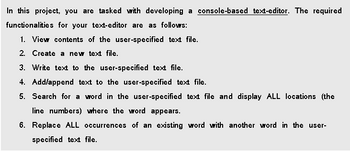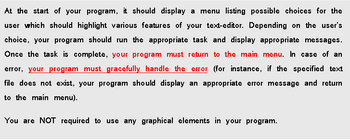
The code should be in C++, the hints for this are...
1. To search for a word in a line of text, you may use the find() function that
works with C++ string objects.
2. While implementing the search and replace functionality, you may need to make
a temporary copy of the text file.


Trending nowThis is a popular solution!
Step by stepSolved in 3 steps

So, there is a infinite loop after needing to press ctrl+z and enter after adding text to the file, and when I do the append text, the ctrl+z+enter doesn't work, this also blocks me from searching for a word and replacing words.
So, there is a infinite loop after needing to press ctrl+z and enter after adding text to the file, and when I do the append text, the ctrl+z+enter doesn't work, this also blocks me from searching for a word and replacing words.
- PROBLEM 1: Have you ever wondered how websites validate your credit card number when you shop online? They do not check a large database of numbers. Most credit providers rely on a checksum formula for distinguishing valid numbers from random collections of digits (or typing mistakes). The objective of this lab you will implement a program that read a file that contains a table with two columns: A column of customer names and a column of credit card numbers. For each customer, print the validity of the credit card number and name of the corresponding credit card company (if the number is valid), For our purpose, the algorithm that valid credit cards is the following: Double the value of every second digit beginning from the right. That is, the last digit is unchanged; the second-to-last digit is doubled; the third-to-last digit is unchanged; and so on. For example, [1,3,8,6] becomes [2,3,16,6] Add the digits of the doubled values and the undoubled digits from the original number. For…arrow_forwardPlease write a full C++ and name the multiple files. Also, include the actual code and not a screenshot please. Please provide the code itself and not just the outputarrow_forwardHello, can someone help me with this assignment? I am trying to do it on Python language: Develop a program that first reads in the name of an input file, followed by two strings representing the lower and upper bounds of a search range. The file should be read using the file.readlines() method. The input file contains a list of alphabetical, ten-letter strings, each on a separate line. Your program should output all strings from the list that are within that range (inclusive of the bounds). Ex: If the input is: input1.txt ammoniated millennium and the contents of input1.txt are: aspiration classified federation…arrow_forward
- write in c++Write a program that would allow the user to interact with a part of the IMDB movie database. Each movie has a unique ID, name, release date, and user rating. You're given a file containing this information (see movies.txt in "Additional files" section). The first 4 rows of this file correspond to the first movie, then after an empty line 4 rows contain information about the second movie and so forth. Format of these fields: ID is an integer Name is a string that can contain spaces Release date is a string in yyyy/mm/dd format Rating is a fractional number The number of movies is not provided and does not need to be computed. But the file can't contain more than 100 movies. Then, it should offer the user a menu with the following options: Display movies sorted by id Display movies sorted by release date, then rating Lookup a release date given a name Lookup a movie by id Quit the Program The program should perform the selected operation and then re-display the menu. For…arrow_forwardIn c++ and without the use of vectors, please. Thanks very much! A contact list is a place where you can store a specific contact with other associated information such as a phone number, email address, birthday, etc. Write a program that first takes as input an integer N that represents the number of word pairs in the list to follow. Word pairs consist of a name and a phone number (both strings). That list is followed by a name, and your program should output the phone number associated with that name. Define and call the following function. The return value of FindContact is the index of the contact with the provided contact name. If the name is not found, the function should return -1 This function should use binary search. Modify the algorithm to output the count of how many comparisons using == with the contactName were performed during the search, before it returns the index (or -1). int FindContact(ContactInfo contacts[], int size, string contactName) Ex: If the input is: 3…arrow_forwardC++Create a text file storage for the list of movies and store your those movies in a linked list when you retrieved them from the text file. They must also be stored in a linked list data structure during processing. Saving back to the text file will be done when the user chooses to Exit the Program.arrow_forward
- Write a program in C++ that prints a sorted phone list from a database of names and phone numbers. The data is contained in two files named "phoneNames.txt" and "phoneNums.txt". The files may contain up to 2000 names and phone numbers. The files have one name or one phone number per line. To save paper, only print the first 50 lines of the output. Note: The first phone number in the phone number file corresponds to the first name in the name file. The second phone number in the phone number file corresponds to the second name in the name file. etc. You will find the test files in the Asn Five.ziparrow_forwardIn c++ and please without the use of vectors. Thanks very much! A contact list is a place where you can store a specific contact with other associated information such as a phone number, email address, birthday, etc. Write a program that first takes as input an integer N that represents the number of word pairs in the list to follow. Word pairs consist of a name and a phone number (both strings). That list is followed by a name, and your program should output the phone number associated with that name. Define and call the following function. The return value of FindContact is the index of the contact with the provided contact name. If the name is not found, the function should return -1 This function should use linear search. Modify the algorithm to output the count of how many comparisons were performed during the search, before it returns the index (or -1). int FindContact(ContactInfo contacts[], int size, string contactName) Ex: If the input is: 3 Joe 123-5432 Linda 983-4123…arrow_forwardUsing c++ Contact list: Binary Search A contact list is a place where you can store a specific contact with other associated information such as a phone number, email address, birthday, etc. Write a program that first takes as input an integer N that represents the number of word pairs in the list to follow. Word pairs consist of a name and a phone number (both strings). That list is followed by a name, and your program should output the phone number associated with that name. Define and call the following function. The return value of FindContact is the index of the contact with the provided contact name. If the name is not found, the function should return -1 This function should use binary search. Modify the algorithm to output the count of how many comparisons using == with the contactName were performed during the search, before it returns the index (or -1). int FindContact(ContactInfo contacts[], int size, string contactName) Ex: If the input is: 3 Frank 867-5309 Joe…arrow_forward
- PYTHON Complete the function below, which takes two arguments: data: a list of tweets search_words: a list of search phrases The function should, for each tweet in data, check whether that tweet uses any of the words in the list search_words. If it does, we keep the tweet. If it does not, we ignore the tweet. data = ['ZOOM earnings for Q1 are up 5%', 'Subscriptions at ZOOM have risen to all-time highs, boosting sales', "Got a new Mazda, ZOOM ZOOM Y'ALL!", 'I hate getting up at 8am FOR A STUPID ZOOM MEETING', 'ZOOM execs hint at a decline in earnings following a capital expansion program'] Hint: Consider the example_function below. It takes a list of numbers in numbers and keeps only those that appear in search_numbers. def example_function(numbers, search_numbers): keep = [] for number in numbers: if number in search_numbers(): keep.append(number) return keep def search_words(data, search_words):arrow_forwardIn C++ Develop a simple spell checker and word suggestion program using Hashing. A dictionary of words should be given as a first argument (filename) in the program. This input file is the simple text file "Dictionary.txt", where each line is a word (see Files section). The program must ask the user to give a word. (case 1) The program must respond with “True” if the word exists in the dictionary, and must suggest words (from Dictionary) starting with the same first two letters. At the end of each suggestion the exec. time (in micro-sec) must be displayed (see "TimeInterval.h" in Files section). (case 2) If the input word does not exist in Dictionary due to user misspelling, and considering the first letter is correct, the program should return a recommended word from the dictionary (only one word). For example, instead of the word sentence, the user enters snetence, setnence, sentens, or setence, etc; the program should return: "do you mean sentence?" If "no", return "false". If…arrow_forwardI need help with this assignment, I need to make a struct to implement a limited Python style list in C++. When you bootstrap the exercise, you will be given a main.cpp file, with a simple program written in it. The program declares a Python style list and appends several elements to it, before printing it out to the terminal. The file is where I would setup my code #ifndef PY_LIST_H #define PY_LIST_H #include <iostream> struct PyList { // Declare your vars here PyList(){ // Implement this } void append(int x){ // Implement this } void append(char x){ // Implement this } void append(float x){ // Implement this } ~PyList(){ // Implement this } }; std::ostream& operator<<(std::ostream& os, const PyList& pyList){ os << '['; // Complete this implementation os << ']'; return os; } #endif Here is the main.cpp file that it must be able to run and the float must not have floating zeros #include <iostream> #include "PyList.h"…arrow_forward
 Database System ConceptsComputer ScienceISBN:9780078022159Author:Abraham Silberschatz Professor, Henry F. Korth, S. SudarshanPublisher:McGraw-Hill Education
Database System ConceptsComputer ScienceISBN:9780078022159Author:Abraham Silberschatz Professor, Henry F. Korth, S. SudarshanPublisher:McGraw-Hill Education Starting Out with Python (4th Edition)Computer ScienceISBN:9780134444321Author:Tony GaddisPublisher:PEARSON
Starting Out with Python (4th Edition)Computer ScienceISBN:9780134444321Author:Tony GaddisPublisher:PEARSON Digital Fundamentals (11th Edition)Computer ScienceISBN:9780132737968Author:Thomas L. FloydPublisher:PEARSON
Digital Fundamentals (11th Edition)Computer ScienceISBN:9780132737968Author:Thomas L. FloydPublisher:PEARSON C How to Program (8th Edition)Computer ScienceISBN:9780133976892Author:Paul J. Deitel, Harvey DeitelPublisher:PEARSON
C How to Program (8th Edition)Computer ScienceISBN:9780133976892Author:Paul J. Deitel, Harvey DeitelPublisher:PEARSON Database Systems: Design, Implementation, & Manag...Computer ScienceISBN:9781337627900Author:Carlos Coronel, Steven MorrisPublisher:Cengage Learning
Database Systems: Design, Implementation, & Manag...Computer ScienceISBN:9781337627900Author:Carlos Coronel, Steven MorrisPublisher:Cengage Learning Programmable Logic ControllersComputer ScienceISBN:9780073373843Author:Frank D. PetruzellaPublisher:McGraw-Hill Education
Programmable Logic ControllersComputer ScienceISBN:9780073373843Author:Frank D. PetruzellaPublisher:McGraw-Hill Education





